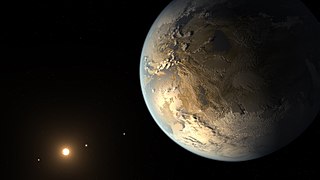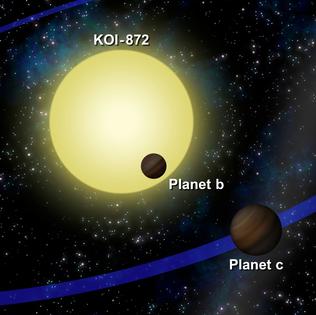Related Research Articles

An exomoon or extrasolar moon is a natural satellite that orbits an exoplanet or other non-stellar extrasolar body.

These are lists of exoplanets. As of 21 September 2023, there are 5,523 confirmed exoplanets in 4,112 planetary systems, with 932 systems having more than one planet. Most of these were discovered by the Kepler space telescope. There are an additional 1,984 potential exoplanets from Kepler's first mission yet to be confirmed, as well as 977 from its "Second Light" mission and 4,512 from the Transiting Exoplanet Survey Satellite (TESS) mission.

Any planet is an extremely faint light source compared to its parent star. For example, a star like the Sun is about a billion times as bright as the reflected light from any of the planets orbiting it. In addition to the intrinsic difficulty of detecting such a faint light source, the light from the parent star causes a glare that washes it out. For those reasons, very few of the exoplanets reported as of April 2014 have been observed directly, with even fewer being resolved from their host star.
This page describes exoplanet orbital and physical parameters.

A circumbinary planet is a planet that orbits two stars instead of one. The two stars orbit each other in a binary system, while the planet typically orbits farther from the center of the system than either of the two stars. In contrast, circumstellar planets in a binary system have stable orbits around one of the two stars, closer in than the orbital distance of the other star. Studies in 2013 showed that there is a strong hint that a circumbinary planet and its stars originate from a single disk.

Transit-timing variation is a method for detecting exoplanets by observing variations in the timing of a transit. This provides an extremely sensitive method capable of detecting additional planets in the system with masses potentially as small as that of Earth. In tightly packed planetary systems, the gravitational pull of the planets among themselves causes one planet to accelerate and another planet to decelerate along its orbit. The acceleration causes the orbital period of each planet to change. Detecting this effect by measuring the change is known as transit-timing variations. "Timing variation" asks whether the transit occurs with strict periodicity or if there's a variation.

Kepler-9 is a sunlike star in the constellation Lyra. Its planetary system, discovered by the Kepler Mission in 2010 was the first detected with the transit method found to contain multiple planets.

Kepler-11b is an exoplanet discovered around the star Kepler-11 by the Kepler spacecraft, a NASA-led mission to discover Earth-like planets. Kepler-11b is less than about three times as massive and twice as large as Earth, but it has a lower density, and is thus most likely not of Earth-like composition. Kepler-11b is the hottest of the six planets in the Kepler-11 system, and orbits more closely to Kepler-11 than the other planets in the system. Kepler-11b, along with its five counterparts, form the first discovered planetary system with more than three transiting planets—the most densely packed known planetary system. The system is also the flattest known planetary system. The discovery of this planet and its five sister planets was announced on February 2, 2011, after follow-up investigations.

Kepler-46, previously designated KOI-872, is a star located in the constellation Lyra. Observed since 2009 by the Kepler space observatory, it has since been found to possess a planetary system consisting of at least three planets and while it has a similar mass to the Sun (90%) it is significantly older at ten billion years.
Kepler-36 is a star in the constellation of Cygnus with two known planets. It has an anomalously large radius, meaning that it is a subgiant.
Kepler-47 is a binary star system in the constellation Cygnus located about 3,420 light-years away from Earth. The stars have three exoplanets, all of which orbit both stars at the same time, making this a circumbinary system. The first two planets announced are designated Kepler-47b, and Kepler-47c, and the third, later discovery is Kepler-47d. Kepler-47 is the first circumbinary multi-planet system discovered by the Kepler mission. The outermost of the planets is a gas giant orbiting within the habitable zone of the stars. Because most stars are binary, the discovery that multi-planet systems can form in such a system has impacted previous theories of planetary formation.
PH1b, or by its NASA designation Kepler-64b, is an extrasolar planet found in a circumbinary orbit in the quadruple star system Kepler-64. The planet was discovered by two amateur astronomers from the Planet Hunters project of amateur astronomers using data from the Kepler space telescope with assistance of a Yale University team of international astronomers. The discovery was announced on 15 October 2012. It is the first known transiting planet in a quadruple star system, first known circumbinary planet in a quadruple star system, and the first planet in a quadruple star system found. It was the first confirmed planet discovered by PlanetHunters.org. An independent and nearly simultaneous detection was also reported from a revision of Kepler space telescope data using a transit detection algorithm.
Kepler-80, also known as KOI-500, is a red dwarf star of the spectral type M0V. This stellar classification places Kepler-80 among the very common, cool, class M stars that are still within their main evolutionary stage, known as the main sequence. Kepler-80, like other red dwarf stars, is smaller than the Sun, and it has both radius, mass, temperatures, and luminosity lower than that of our own star. Kepler-80 is found approximately 1,223 light years from the Solar System, in the stellar constellation Cygnus, also known as the Swan.
Kepler-65 is a subgiant star slightly more massive than the Sun and has at least four planets.
Kepler-88 is a Sun-like star in the constellation of Lyra, with three confirmed planets. In April 2012, scientists discovered that a Kepler candidate known as KOI-142.01 (Kepler-88b) exhibited very significant transit-timing variations caused by a non-transiting planet. Timing variations were large enough to cause changes to transit durations to Kepler-88b as well. Large transit-timing variations helped to put tight constraints to masses of both planets. The non-transiting planet was further confirmed through the radial velocity method in November 2013.

Kepler-90g is a super-puff exoplanet orbiting the early G-type main sequence star Kepler-90, one of eight planets around this star discovered using NASA's Kepler space telescope. It is located about 2,840 light-years (870 pc) from Earth, in the constellation Draco. The exoplanet was found by using the transit method, in which the dimming effect that a planet causes as it crosses in front of its star is measured. It orbits its parent star about every 210.5 days at a distance of 0.71 astronomical units.

Kepler-56b (KOI-1241.02) is a hot Neptune—a class of exoplanets—located roughly 3,060 light-years away. It is somewhat larger than Neptune and orbits its parent star Kepler-56 and was discovered in 2013 by the Kepler Space Telescope.
Kepler-277c is the third most massive and second-largest rocky planet ever discovered, with a mass about 64 times that of Earth. Discovered in 2014 by the Kepler Space Telescope, Kepler-277c is a Neptune-sized exoplanet with a very high mass and density for an object of its radius, suggesting a composition made mainly of rock with some amounts of water. Along with its sister planet, Kepler-277b, the planet's mass was determined using transit-timing variations (TTVs).

HATS-36b is a gas giant exoplanet that orbits an F-type star. Its mass is 3.216 Jupiters, it takes 4.2 days to complete one orbit of its star, and is 0.05425 AU from it. It was discovered on June 12, 2017 and was announced in 2018. Its discoverers were 23, namely Daniel Bayliss, Joel Hartman, George Zhou, Gaspar Á. Bakos, Andrew Vanderburg, J. Bento, L. Mancini, S. Ciceri, Rafael Brahm, Andres Jordán, N. Espinoza, M. Rabus, T. G. Tan, K. Penev, W. Bhatti, M. de Val-Borro, V. Suc, Z. Csubry, Th. Henning, P. Sarkis, J. Lázár, I. Papp, P. Sári.
References
- ↑ Thomas H. Maugh II (2012-06-21). "Astronomers find unlikely pair of planets orbiting star". Los Angeles Times . Retrieved 2012-06-21.
- 1 2 Carter, J. A.; et al. (2012). "Kepler-36: A Pair of Planets with Neighboring Orbits and Dissimilar Densities". Science. 337 (6094): 556–559. arXiv: 1206.4718 . Bibcode:2012Sci...337..556C. doi:10.1126/science.1223269. PMID 22722249. S2CID 40245894.
- ↑ Bodenheimer, P.; Stevenson, D.; Lissauer, J.; D'Angelo, G. (2018). "New Formation Models for the Kepler-36 System". The Astrophysical Journal. 868 (2): id. 138 (17 pp.). arXiv: 1810.07160 . Bibcode:2018ApJ...868..138B. doi: 10.3847/1538-4357/aae928 . S2CID 59055335.


